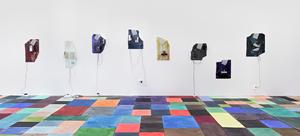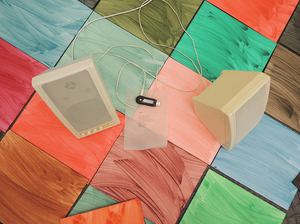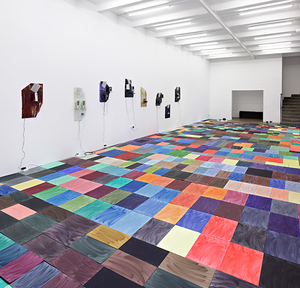Texte: 2013
FRIEZE FOCUS: Lyrik, Farbe und die Vermessung von Bewegung
Was für ein Chaos. Wer im Januar diesen Jahres Natalie Häuslers Einzelausstellung Case Mod in ihrer Berliner Galerie Supportico Lopez besuchte, fand dort nicht vor, was die Webseite der Galerie versprach. Fotos von Häuslers Installation monika/subway (floor piece) (2012) ließen ein Raster klar angeordneter Kartonplatten in knalligen Acrylfarben erwarten, die den gesamten Boden des Hauptraums bedeckten. Doch stattdessen lagen die Platten wild über den Boden verstreut, verschmutzt mit dreckigen Schuhabdrücken. Häusler hatte die Platten zwar höchst sorgfältig arrangiert, aber offensichtlich nicht fixiert. Und so verschoben sich die Kartonagen mit jedem Schritt der Eröffnungsgäste und Besucher wieder. Die Platten am Eingang sahen dabei besonders mitgenommen aus, diejenigen entlang der Wände waren dagegen eher verschont geblieben. monica/subway erschien nur am Anfang als Raster aus fröhlichen Farbtönen – und zeigte am Ende doch viel eher die Spuren der Besucher. Diese ständige sich verstärkende Bewegung gewann schnell eine beunruhigende Dimension. Ein wenig wirkte das Ganze, als ob man der Schneise der Verwüstung folgt, die ein Tornado hinterlässt, oder der Spur von Menschen in Massenpanik. Und doch: Filmt man einen Wirbelsturm in Zeitlupe, so sieht er beinahe aus wie ein Ballett der Objekte. Vielleicht ging es in Häuslers Installation ja genau darum: um das Ausmessen von Bewegung, Geschwindigkeit und Dauer – und zwar in einer Art Action Painting im erweiterten Feld.
Dieses Feld umfasst nicht nur Malerei und Installation, sondern auch Dichtung. Häusler verschmilzt alle drei Bereiche miteinander – was es ihr erlaubt, ganz unterschiedliche Wege des Ausstellens, Schreibens, Lesens, Vortragens und Zuhörens einzuschlagen. Die Künstlerin wurde in München geboren und zog 2012 – nach zwei Jahren als DAAD-Stipendiatin in New York – nach Berlin. 2011 schloss sie das Bard College mit einem Master of Fine Arts ab und das Studium an der HdK Braunschweig als Meisterschülerin – beides in Malerei. Im gleichen Jahr gründete sie gemeinsam mit Ed Steck und Brett Price den Lyrik-Verlag AMERICAN BOOKS. Das erste Buch des Verlags – Solicitations, mit Beiträgen von 35 Künstlern und Autoren – erschien im Dezember 2012. Schon 2010 tauchte das erste Gedicht Häuslers in einem ihrer Kunstwerke auf, LOSS – LUST I, und zwar in einer Installation und Performance gleichen Namens, die am Bard College aufgeführt wurde. Die auf Kanzleipapier gedruckten Zeilen des Gedichts wurden von zwei Freunden Häuslers laut vorgelesen und dann in der Installation verstreut. Das teilweise auf Deutsch, größtenteils aber auf Englisch geschriebene Gedicht zitiert einen Brief von Franz Kafka aus dem Jahr 1920, in dem Kafka seine Geliebte Milena Jesenská davon zu überzeugen versucht, dass sie ein klareres Bild voneinander hätten, wenn sie sich, statt sich zu treffen, lieber schrieben. Und Häusler fügt dem ihre eigenen Überlegungen zu Undurchsichtigkeit und Einsicht im Verhältnis zwischen Künstlern, Werken und Zuschauern hinzu: „Einen Arbeitsprozess sichtbar zu machen, macht Dich verwundbar.“ Während ihre Freunde diese Zeilen lesen, verspritzt Häusler Tinte auf die Textilien und die Broschüren der Installation, die alle ein bisschen wie Rorschachtests wirken oder zumindest zensiert aussehen – entweder also nach Interpretation oder nach Unlesbarkeit. Längst erscheinen Häuslers Gedichte nicht mehr nur auf Papier. Sie bedient sich dafür ganz anderer materieller Träger und lotet Handlungen jenseits des Rezitierens aus. For Anne (rising) (2012) – eine Installation im Schaufenster des Berliner Buchladens Motto – enthielt auf zerbrochene Sektgläser gedruckte Auszüge aus ihrem Gedicht BED. Andere Installationen wie A situation of subtle control/inward-outward gaze (2011) und We are getting a little bit too close here (still life) (2012), die letztes Jahr anlässlich der Shortlist-Ausstellung des +6| 2012-Columbus-Förderpreises in der Kunsthalle Ravensburg zu sehen waren, zeigen auf tischähnliche Flächen gedruckte Gedichte. Doch die Worte wirken verzogen, so als schwebten sie im Wasser oder wären im Zerrspiegel einer Jahrmarktsbude gespiegelt. Häusler mag solche Bewegungseffekte – vielleicht als eine textliche Variante von Drip Painting – ebenso wie Paletten, die Farben miteinander verbinden und gleichzeitig voneinander absetzen: Plattenraster, Bildschirmschoner, Wasserfarben, Buntglas. Bei Case Mod hingen acht Bruchstücke von bemaltem Glas in einer Reihe an einer Wand des Ausstellungsraums; ein jedes mit einem Gedicht auf Pauspapier versehen, sowie mit einem schon etwas in die Jahre gekommenen MP3-Player. Man konnte die Gedichte entweder lesen oder über Kopfhörer anhören – zumindest so lange, bis die Batterien alle waren. Und die Ausstellung arbeitet noch mit einer weiteren Zeitmessung: Das Buch WATERCOLOURS (2012) versammelt ein Jahr Email-Korrespondenz zwischen Häusler und ihrem Künstlerkollegen David Horwitz, inklusive Illustrationen.
Vielleicht möchte Häusler, die im Mai eine sechsmonatige Künstlerresidenz an der Cité des Arts in Paris antritt, mit der Verwendung von Dichtung ja auch der Tatsache entgegenwirken, dass Sprache in der bildenden Kunst rein zu Erklärungszwecken eingesetzt wird; denn momentan kranken so viele postkonzeptionelle und research-basierte Werke genau daran. Häuslers Poetik-Version erweiterten Actionpaintings betont letztendlich nicht ihre eigenen Aktionen, sondern die der Zuschauer – sie verweist darauf, wie diese die Kunst „abnutzen“, sei es durch ihre Interpretationen oder durch schiere physische Anwesenheit. What pilgrims trust they shall encounter (Advanced Morandi Effect / Mere Exposure Effect (2012) zeigte im Vorjahr – ebenfalls bei Supportico Lopez – einen Tisch mit dicht aneinander gereihten, randvoll mit Wasser gefüllten Trinkgläsern. Wenn man sich dem Werk näherte, erzitterten die Gläser von den Fußtritten sicht- und hörbar. Trat man ganz dicht heran, dann klapperten sie wie Zähne, ganz so, als flöße ihnen schon die Aussicht auf Annäherung Furcht ein.
Link zum Artikel:
https://frieze.com/article/natalie-h%C3%A4usler?language=de
Case Mod, Verschiedene Materialen, Ausstellungsansicht Supportico Lopez, Berlin, 2013 (Courtesy: die Künstlerin and Supportico Lopez, Berlin, Fotografie: Hans-Georg Gaul)
Artforum Critics' Picks: Natalie Häusler
Combining sound, painting, text, and sculptural elements, Natalie
Häusler’s latest exhibition, “Case Mod,” blurs the division between
engaging with an artwork sensorially and approaching it cerebrally.
Spreading across the gallery’s floor is a Color Field painting
consisting of cardboard tiles washed in vibrant acrylic paint. Titled
Subway/Monika (floor piece) (all works 2012), the piece evokes the
Emergency Broadcast System image that used to flash across
television screens. Hung on the gallery wall are ten sculptures:
Each is made of broken stained glass and consists of shelves on
which an MP3 player and speakers play sound tracks featuring the
voices of the artist’s friends reciting poetry she has penned herself.
In order to hear each poem, one must lean in—but the edges of
each piece are sharp, acting almost as warnings not to get too
close. The texts of the respective poems are printed on transparent
paper and draped over the top of each shelf,
softening the boundaries
of the shelves and almost turning them into works of concrete poetry.
The title of the show comes from case modification, the practice of altering
the chassis of a computer hard drive in
an attempt to show off some special
or unique feature. While the only thing being modified in the gallery is the
floor,
and then only nonpermanently, the works in this exhibition activate
the viewer’s capacity to transform a complex of
sound, text, and art into his
or her own artistically enjoyable experience.
SUPPORTICO LOPEZ
Kurfürstenstrasse 14/b
January 11–February 16
All rights reserved. artforum.com is a registered trademark of Artforum
International Magazine, New York, NY
Natalie Häusler, Case Mod
Case Mod
Natalie Häusler’s installation Case Mod
(from: Case Modification) exacts from the gallery space a field in which
intimate and reciprocal encounters between audience and art practice
are put to the test. Häusler compiles a situation, combining several
elements derived from a simultaneity of studio and writing practice.
Emerging forms, in this case, watercolor, sculpture and poetry, query
whether they can uphold their fragilities and force of expression when
exposed to the viewer and to each other. They articulate their mutuality
when arranged in the exhibition space, producing crosscuts and
intimacies, of visual, written and audio material, as well as of object
and spectator / reader / listener. The audience becomes belated witness of
the art practice as such, which the installation at once showcases and
archives. Yet the present moment is highlighted, as the visitors leave
their own marks on the piece, subtly shifting the color palette or
destroying it altogether. Audio recordings of the voices of close
friends, who are practicing artists and writers, reciting the poems,
track down their intimate reception by an audience that is involved in
both activities, production and reception. They capture the moment of
surprise, when the poem was read for the first time. The intimacy of
this contact is shared with the passing visitor, who must come close to
the audio shelf, to be able to hear the individual reading. These
shelves, each of which is cut and built from one sheet of stained glass,
and customized for its assigned set of outmoded electronic equipment,
serve as seductive support and hazardous repellant at the same time. The
temporary construction of a space of this kind is part of Häusler’s
inquiry of forms of intimacy, risk, close contact with the material, and
inclusion to question modes of reception.
____
plums and fruit and knife
and knives and knife
and plum and bite
and fruit and juice
and cut and bite
and flesh and plum
and plum and plums
and cut and flesh and juice
Language, or “knife”, if we follow the poem, can break the rules a poem has set up for itself. Here, “knife” cuts the semantic chain that fruit and plum, as a whole-part lexical relation, establishes, and therefore makes the poem change course. We ask whether such clean incisions into an artwork’s inner logic can be achieved in visual practice as well. Natalie Häusler’s installation Case Mod (i.e. from: Case Modification) attempts to master the art of incision that poetic language seems to achieve with such elegance and directness. Language, bound by the laws of signification, allows for such sudden moves that can cause a drastic re-shuffling of the poem’s continued logic and imagery. Yet whereas “knife” can terrorize and hijack the lines of the poem, the knife-drawing on silk remains in direct and three-dimensional contact with its neighbors, the other artworks. It
hovers above and among them as a large exclamation mark or downward thrust, but its support, silk that remains fluid and in motion, is emblematic of "knife's" continuity with a constructed and to a large extent fixed environment that moves forward in time on a single spatial axis. “Knife” within the installation also cuts open the installation and attempts a rupture, but the installation will not yield and abandon the other things it has gathered and brought together. It is the poem itself that gives us a taste for such continuing oscillation and movement in the image of “juice”, palette fluid matter that erupts from the cut object, spilling the poem and rendering its borders fluid. Similarly, Häusler constructs a floor from monochrome paintings on cardboard that ask for something to be spilled on their already water-based, painted surface, to wash its colors, shift the palette, soak and dissolve it.
As parallel to the poem’s stark shifts of image registers, the shifts in the installation take place on the fluid surfaces of painting, which cause more finely tuned ruptures. The color mosaics, installed on the gallery floor, are painted in monochrome, warm hues, but are also configured as a structural grid. By that Häusler emphasizes the possibilities for variation and non-permanence of the grids that serve both as painting and architectural support.
Wall shelves built from tinted glass echo the monochrome palette of the floor painting, but also serve as structural support for the exhibition of Häusler’s poems, both in audio and print format. They break the sound waves that emanate from the audio speakers they carry, and become catalysts for the dispersal of Häusler’s poem’s in the exhibition space. The poems are read out loud by close friends, who are practicing artist and writers. They track down a moment of intimate reception by these readers who are involved in both the production and reception of the poem. The intimacy of this contact is shared with the passing visitor, who must come close to the audio shelf to be able to hear the individual poem. These shelves, each cut and built from one sheet of stained glass, each customized for its assigned set of outmoded electronic equipment, serve as seductive support and hazardous repellant at the same time.
Thus, the combined material oscillates between structural grid, and the contingencies and intimacies of painterly and poetic practice. The visitor finds her or himself in between those dynamic poles. Thus the installation both draws, even coerces the visitor into co-creating its surfaces, yet inserts antagonistic lines and breakages into those spaces of intimacy. The temporary construction of a space of this kind is part of Häusler’s inquiry into forms of intimacy, risk, close contact with the material, and inclusion as forms of reception.
Natalie Häusler’s installation Case Mod exacts from the gallery space a field in which she puts intimate and reciprocal encounters between audience and art practice to the test. Her work interrogates the installation space as a space of social and political relevance, not by making statements via an argumentative dialectics, but through observation, commentary and systematic disruption, for which the inclusion of her poetry serves as focal point. Her commentary emanates from and necessarily includes the subjective, which she insists must remain visible in her work. Häusler generates systems and constructions that colonize the exhibition space in an exacting fashion, yet builds into these exhaustive structures parts that will disintegrate, that can spill and are fluid. Her poems, and language as such, remain part of the installation as points of contraction and literacy. They activate the gallery space as literate, social, and by extension political space. The convergence of poetic and visual practice is never hierarchical nor does one cancel out or override the other. Rather, the act of exhibiting her poems activates their potential for a formal as well as critical multi-dimensionality and both practices enter into a binding contract, which demands of these forms to remain accountable, to each other as well as to the viewer.
The book “Watercolors” documenting a one and a half year long correspondence in form of watercolors sent via email between Natalie Häusler and Californian artist David Horvitz is part of the exhibition. A book launch will be held on January 12th at Motto Berlin.
__
Case Mod
11 January – 16 February 2013
Supportico Lopez, Berlin

















